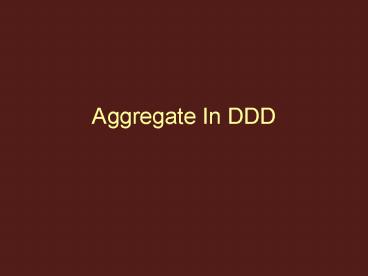Aggregate In DDD - PowerPoint PPT Presentation
1 / 10
Title:
Aggregate In DDD
Description:
Aggregate In DDD. What makes an ENTITY. AGGREGATE root. Has global identity. ... AGGREGATE in modeling process(2) ... refine domain model. AGGREGATE in codes ... – PowerPoint PPT presentation
Number of Views:349
Avg rating:3.0/5.0
Title: Aggregate In DDD
1
Aggregate In DDD
2
What makes an ENTITY AGGREGATE root
- Has global identity.
- Expected to be directly accessed in typical
business scenarios. - If it has other objects to take care of and
- Manage lifecycle of internal objects within its
boundary. - Control all access to internal objects.
- Enforce invariants/integrity in transactions.
3
AGGREGATE in modeling process(1)
- Separate domain LAYERS.
- Identify ENTITY and VALUE objects in domain
layer. - Identify AGGREGATE root of ENTITIES and define
its boundary. - Create REPOSITORY for AGGREGATE root.
4
AGGREGATE in modeling process(2)
- Consider creation of objects (constructor,
AGGREGATE root, FACTORY). - Clarify responsibilities and put objects into
proper MODULES and LAYERS. - Iteratively discover and refine domain model.
5
AGGREGATE in codes(1)
- AGGREGATE root creates internal objects.
- Part part root.AddPart(part-1)
- Part part new Part(root, part-1)
- root.AddPart(part)
6
AGGREGATE in codes(2)
- ONLY provide accessibility through REPOSITORY for
AGGREGATE root. Other objects must be found by
traversal of associations. - Nothing outside the aggregate boundary can hold a
reference to anything inside, except the root.
(deleting operation has no side effects.) - ENTITYES inside boundary have local identity,
unique within AGGREGATE.
7
AGGREGATE in codes(3)
- AGGREGATE root holds internal object related
logic for some cases. - Objects within AGGREGATE can hold references to
other AGGREGATE roots.
8
Defining boundary(1)
- Listen to typical business scenarios, be
pragmatic on defining boundary. - Be referenced by an AGGREGATE root does not mean
being aggregated. - Entity accessed through different paths
(AGGREGATE roots) in different scenarios usually
worth making itself its own AGGREGATE root.
9
Defining boundary(2)
- Use this pattern
- "No one would look up A directly without
wanting the B itself. - instead of the below one
- the A is not integrated/valid conceptually
without an B.
10
Not mentioned topics
- NHibernate cascading strategy for AGGREGATE.
- Typical trade-offs when implementing AGGREGATE.































